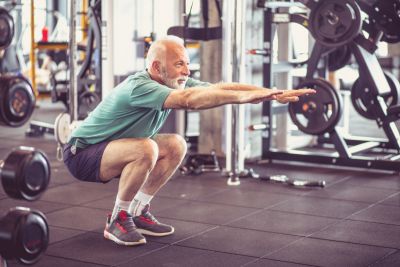Testosterone, the primary male sex hormone, plays a crucial role in many aspects of a man's life, including sexual function, muscle mass, bone density, and even mood.
While testosterone levels naturally decline with age in a process known as andropause, there are steps you can take to fight back and boost your testosterone, though it’s important to note that men with clinically low testosterone won’t be able to reverse low T through exercise alone.
For men who simply want to boost their levels and fight back against age-related declines, one of the most effective methods is through regular exercise—especially certain types of exercise, like HIIT and resistance training (like weight lifting).
The Relationship Between Exercise and Testosterone
Numerous studies have shown that engaging in regular physical activity can significantly impact testosterone levels in men. Exercise, particularly resistance training and high-intensity interval training (HIIT), has been found to be most effective in boosting testosterone production.
When you engage in resistance training, such as weightlifting, your body is challenged to adapt to the increased stress placed upon your muscles. This adaptation process triggers a cascade of hormonal responses, including an increase in testosterone production.
The more muscle mass you stimulate during your workouts, the greater the potential for testosterone release.
HIIT, which involves short bursts of intense exercise followed by periods of rest or low-intensity activity, has also been shown to cause a significant increase in testosterone levels, usually somewhere in the range of 20% to 40%.
This type of training is thought to stimulate the production of luteinizing hormone (LH), which in turn signals the testes to produce more testosterone.
It's important to note that the testosterone-boosting effects of exercise are not limited to young men. Studies have shown that even older men can experience significant increases in testosterone levels through HIIT, and the same has been shown for resistance training.
This is particularly relevant as testosterone levels naturally decline with age, a process known as andropause. By engaging in exercise, older men can help mitigate this decline and maintain healthy testosterone levels well into their later years.
Keep in mind that while 20% to 40% seems high, there’s a big difference between 40% of a total testosterone level of, for example, 100 ng/dL, and 40% of 500 ng/dL.
For most men, anything below 300 ng/dL is considered low regardless of your age. If you’re well below that naturally, HIIT is unlikely to restore you to normal levels.
Optimal Exercise Strategies for Boosting Testosterone
To maximize the testosterone-boosting effects of exercise, it's important to focus on compound movements that engage large muscle groups. Exercises such as squats, deadlifts, bench presses, and rows are particularly effective as they stimulate multiple muscle groups simultaneously, leading to a greater hormonal response.
Aim to perform these exercises with moderate to high intensity, using weights that challenge you for 6 to 12 repetitions per set. You should also try to maintain a high volume of work by performing 3 to 5 sets per exercise and incorporating a variety of compound movements into your routine.
Rest periods between sets should be kept relatively short, around 60 to 90 seconds, to maintain a high level of intensity throughout your workout. Longer rest periods may be necessary for more demanding exercises or heavier lifts but try to keep them under 2 minutes when possible.
When designing your exercise program, it's also important to consider the frequency of your workouts. While the optimal training frequency may vary from individual to individual, most studies suggest that training each muscle group 2 to 3 times per week is ideal. This gives your body plenty of time to recover between workouts while still letting you achieve results.
As you begin to build muscle, your body will naturally begin burning more calories, resulting in weight loss. Because fat can act as an estrogen-producing organ in both men and women, the less you have, the higher your testosterone levels can rise, though some men will need additional help with weight loss, especially if they’ve been carrying a lot of weight for many years.
When Exercise Isn't Enough: Testosterone Replacement Therapy
While exercise can be highly effective in boosting testosterone levels, it's important to recognize that, for men with clinically low testosterone, exercise alone is very unlikely to restore levels to a normal range.
Symptoms of low T include:
● Fatigue
● Decreased muscle mass
● Mild depression and/or anxiety
● Brain fog or difficulty concentrating
If you experience these symptoms, it's important to consult with your healthcare provider to determine if low testosterone is the cause. The most common treatment for low T is testosterone replacement therapy (TRT).
TRT is a medical treatment option for men diagnosed with hypogonadism, the scientific name for low testosterone. There are many different forms of TRT, including injections, gels, pellets, and patches—you’ll also need to choose between synthetic hormones and bioidentical hormones.
Your healthcare provider will likely order a series of tests to measure your hormone levels. If your levels are consistently below the normal range, your provider may diagnose you with hypogonadism and recommend TRT as a treatment option.
If Your T Levels Are Low, TRT May Be the Answer
Maintaining healthy testosterone levels is essential for men's overall health and well-being. While exercise, particularly resistance training and HIIT, can be a powerful tool for boosting testosterone production, it's not enough for everyone, especially if you have clinically low levels.
If you’re experiencing the symptoms of low testosterone, we can help. Learn more about testosterone replacement therapy here or schedule an appointment with a specialist today to discuss your options.

